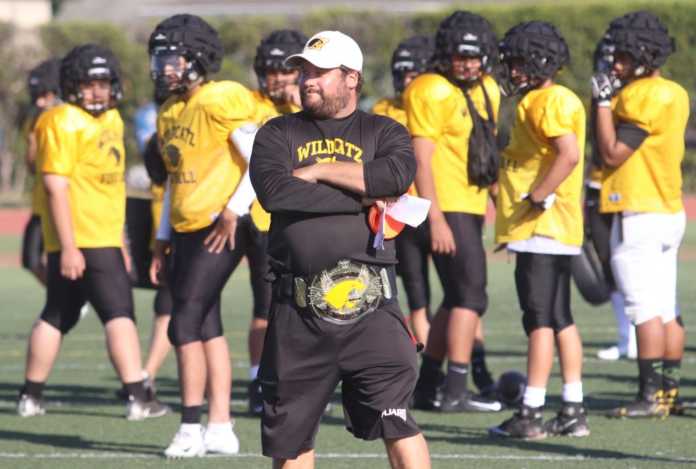Last season’s 6-4 record was a big breakthrough for the Watsonville High football team.
The Wildcatz might have missed the playoffs, but notching the program’s first winning record since 2009 was a sign things are improving for the Black and Gold.
As head coach Ron Myers put it at the end of last fall: “They’re winners. No one can take that away from them.”
As the Wildcatz head into the fifth season of Myers’ second stint (he previously coached the team from 1984-90), I’m tempted to say that no matter what record they finish with this fall, they will be winners in my book.
Watsonville has 63 players on its varsity team, 41 on junior varsity and 46 at the freshman level. Those are numbers that numerous programs across the tri-county would love to have, but can’t seem to replicate.
Sure, Watsonville has the 19th largest enrollment in the Central Coast Section, according to the 2017-18 CBEDS, but more bodies on campus has not always meant more interest in football. The year before Myers took over, Watsonville finished 3-7 overall and dropped its freshman team, following several Santa Cruz County schools in fielding only varsity and frosh-soph squads.
Since taking the reins in 2014, Myers and his coaching staff have rebuilt the lower levels, changed the culture of competition and turned the program into a high school football utopia.
This resurgence shouldn’t be happening in a small city dominated by soccer, and in an era where high school football numbers have been steadily declining for some time.
But it is.
“You have to give credit where credit is due, Ron has done a great job,” said former Watsonville Athletic Director Brad Hubbard, who still helps the school’s athletic programs today. “He had a plan, and he followed through.”
COMPETITION
The California Interscholastic Federation released its annual participation census earlier this month. Overall participation in high school sports was up for the sixth consecutive year, jumping by 2.95 percent — 808,557 high school students competed in sports last school year.
And while football continues to field the largest amount of student-athletes of any sport offered by the CIF, the sport’s numbers shrunk by a significant margin for the third straight season. A total of 94,286 male student-athletes participated in 11-player football last fall, down from 97,079 the year before. Football had 100,205 participants in the fall of 2015, and 103,725 participants in the fall of 2014.
It would be easy to say that with the increase of social media, video games and sports specialization that decrease is to be expected, but the numbers of every sport that runs along side football in the fall have shot up. Boys cross country has gained 3,536 participants since the fall of 2014 (29,415-32,951), and boys water polo has grown by 880 participants since 2013 (16,263-17,143).
Myers said he understands football isn’t quite the “rite of passage” it used to be for boys. The days when hundreds of kids grew up with the dream of playing high school football with their buddies is slowly fading away, at least in Myers’ small farming community.
“You’ve got to compete, and we’re competing with Xbox, with the car, the clothes and the girl,” Myers said. “You have to have something that they want to be a part of.”
His sales pitch?
Straight from the mouth of Michigan coaching great Bo Schembechler: The team, the team, the team.
“What’s No. 1? The team,” Myers said. “What’s the paradox in athletics? Well, at the end of the season we give that one player, the most important player — the MVP. It’s always the last award of the year.”
Myers decided to change that. Watsonville instead closes out its end-of-season banquet with two awards: the Character Award and the Scout Team Player of the Year. Before you throw away the newspaper and yell out, “NOT EVERYONE GETS A TROPHY,” understand this: rewarding the effort of players who make their teammates better — in practice or in games — is the cornerstone of any successful program.
Watsonville also names a Practice Player of the Week. The honoree gets to strut around like a pro wrestler with a replica world championship belt around their waist or draped over their shoulder.
“These are the awards that mean a lot to the guys,” Myers said. “You should see their faces when they win one of these.”
PATIENCE
Of course, many of the juniors and seniors Myers had during his first season didn’t buy in to the team-first mentality immediately — if ever. Like anything worthwhile, the overhaul took time and patience from players, parents, administrators and coaches.
When Myers returned to Watsonville, his first action was to bring back the freshman team. Even though the junior varsity team would have only roughly 20 players on the roster that year, Myers felt keeping the freshmen together was the only way the program would see success in perpetuity.
“You have to have a freshman group that’s happy,” said Myers, who gave props to his coaches at the lower levels: Jim Toumey and Rene Munoz, among others. “If you do frosh-soph, the freshmen never play. If they don’t play, they don’t come back.”
He’s kept that same belief over the years, never moving a freshman up to the junior varsity, and rarely moving a sophomore into varsity.
But three years ago, Myers moved up five sophomores to the varsity program, because he thought they would give the team a better chance to win. Watsonville that season came within a few plays of its first league championship of the decade. Yet Myers came close to calling that move a mistake, because it negatively effected the lower levels.
Would moving up a couple sophomores every other season cause the entire program to implode? Probably not. But stealing five sophomores from the junior varsity team — a level that is entirely dependent on kids in their sophomore year — every season, was something Myers vowed not to do, even if they could help the team win.
Does he have sophomores this year who can play on varsity?
“Sure, but I’ve got 60 guys now. Heck, I think I have some freshmen that can play varsity,” Myers said. “Do we need them? No. Let them play with their friends and get better.”
SAFETY
On the first day of padded practice this fall, Myers unwrapped a brand new top-of-the-line helmet and handed it to a freshman who had been playing football for only three months.
Those of you who did not play football in high school are probably asking yourselves “doesn’t everyone get the same equipment?” Sadly, the answer is no.
I played football at Watsonville from 2006-2009, and I remember walking into the first day of padded practice as a freshman with a helmet from the ’80s that gave me headaches from merely putting it on and taking it off.
“The best helmet you can buy, brand new, guys in the NFL wear these,” Myers said shaking his head. “Our standards are higher, because our district and administration cares about that.”
Three years ago the three Pajaro Valley Unified School District high school athletic directors, with help from Hubbard, asked the district for more funding to make the game safer for the players. The PVUSD obliged, allowing Myers to do what he’s always believed was right.
“I won’t put anything on your kid, that I wouldn’t put on mine,” Myers said. “And our district backs that.”
With the boost in funding, Watsonville has bought 172 “Tier-1” helmets (it had 12 when Myers took over), NCAA-level shoulder pads, “Guardian Caps,” an overlay of padding on top of the helmet, for all three levels and rugby caps for 7-on-7 use.
“All you have to do is open up the newspaper or go on the internet and read these stories,” Hubbard said. “The concerns (around football) are real, and we had to take action to make it as safe as possible. The district understood this at the time, and I hope they continue in the future.”
Especially with the sport at a crossroads. It’s not difficult to find stories of former football greats dealing with the repercussions of the brutally physical sport. Chronic Traumatic Encephalopathy (CTE), a degenerative brain disease found in athletes, military veterans and others with a history of repetitive brain trauma, grabbed the media headlines a handful of years ago and hasn’t faded away since. And now scientists are asking if football collisions are what led to Dwight Clark’s death at the hands of amyotrophic lateral sclerosis (ALS).
The San Francisco 49ers’ legend died of ALS, a nervous system disease that weakens muscles and impacts physical function, on June 4. At the time of his death, nine former NFL players had died of the same disease, according to The Mercury News.
North Monterey County High head coach Sean Gomes recalls watching a recent ESPN documentary on former Oakland Raider defensive back Rickey Dixon, who is slowing dying of ALS.
“It brings a tear to your eye to see this man that was an athlete, that was so big and strong, shrinking down to nothing and can’t communicate with anybody,” Gomes said. “My son asked me, ‘why do you coach?’ It makes you think, ‘how safe can you make this game?’”
Like Watsonville, N.M.C. has invested in new helmets, “Guardian Caps” and 7-on-7 rugby caps. Gomes also follows the USA Football shoulder tackling drills, something Myers said he’s taught since he started coaching in the early ‘80s.
Myers also said he rarely allows kids to join the team at the start of the school year because of safety reasons.
“They’re just too behind,” Myers said. “By the time we get the pads on, we’ve had 26 practices where these kids have learned the fundamentals of tackling without the helmet. You get a kid in pads without those practices, it’s just not safe…What we want is to drill [tackling] until you can’t get it wrong, not until you get it right.”
THE MANTRA
“Who claps?” Myers said. “Everyone.”
It’s a simple mantra, but it’s worked for Watsonville over the last five years.
Someone makes a nice hit. Who claps? Everyone.
Someone gets an interception. Who claps? Everyone.
Someone gets a good grade on a test. Who claps? Everyone.
I’m a reporter, and I try to be unbiased.
I won’t be joining in on the clapping, but I will be admiring how far the program has come in such a short amount of time.
Editor’s Note: Tony’s Thoughts is a reoccurring column from Sports Editor Tony Nunez that dives into the local sports world. Contact Nunez at Tn****@********an.com or 761-7335.









